11 Type of Stone Paw, Physical Character, Color, Habitat and Picture
Who does not know the Stone Mage bird? This type of bird is a popular bird because of its melodious chirp. Its popularity is not only known in Indonesia alone, but also to foreign countries and around the world. Types of stone magpie also vary. Starting from the type of stone magpie stone typical of Indonesia and several other countries such as Thailand, Philippines, and Malaysia.
Excess stone magpie stone that comes from Indonesia compared with other countries that lies in the sound quality with its own uniqueness. Several types of famous stone magpie birds in Indonesia berasi from Sumatra, such as Batu Nias, Jambi, Lahat, Aceh, Medan, and also Lampung. All species of the magpie has its own distinction that is not the same as the others. You can see the difference in the tail of this bird.
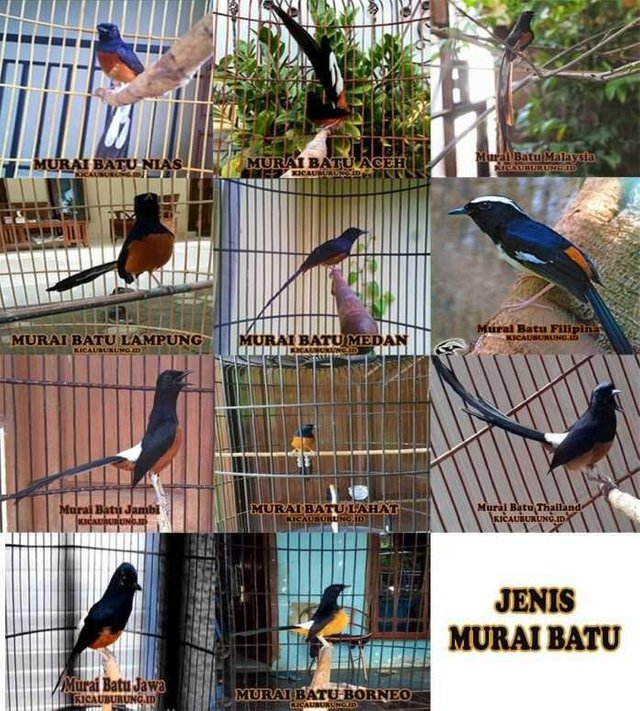
|image source : https://www.kicauburung.id/murai-batu/jenis-murai-batu.html
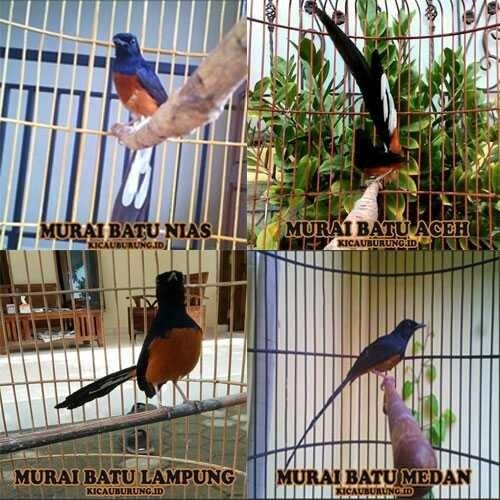
|image source : https://www.kicauburung.id/murai-batu/jenis-murai-batu.html
table of contents
Characteristic Characteristics and Patterns of Stone Moused Tails
Kind of Type of Stone Murals in the World With Pictures and Its Explanation:
- Murai Batu Nias
- Murai Batu Medan
- Murai Batu Lampung
- Murai Batu Borneo / Kalimantan
- Murai Batu Aceh
- Murai Batu Lahat
- Murai Batu Jambi
- Murai Batu Jawa / Murai Batu Larwo
- Murai Batu Malaysia
- Thai Mermaid Stone
- Philippine Mermaid Stone
Characteristic Characteristics and Patterns of Stone Moused Tails
Well, now let's go over the different types of tail patterns from the stone magpie that you can distinguish easily. For the stone magpie from Medan, the color pattern is divided into two. The top for darker tail feather colors, while the bottom of the tail is filled with the color of the brighter tail feathers. Especially for the stone magpie from Aceh, Malaysia, and Thailand, the tail pattern has its own shape of the arch.
The stone magpie birds are the easiest to distinguish from other birds from Nias. The tail is only fully filled by one color only. It is the same for bird species originally from Borneo. For bird species from Sinabang, Lasia, and Lampuyang, you will find little color difference at the tail end only. The uniqueness of this bird can also be found on the type of stone magpie from Malaysia. For more details, you can see pictures of different types of stone magpie stone patterns based on their original region below.
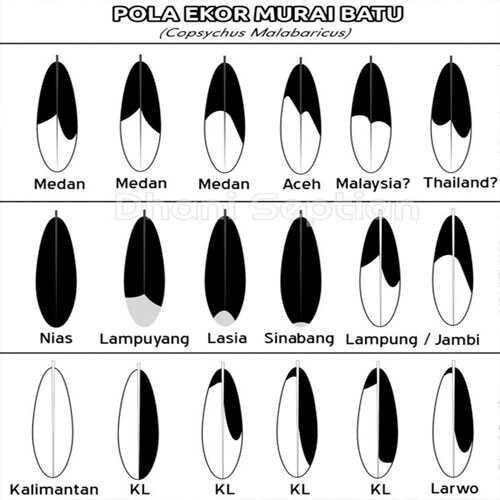
|image source : https://www.kicauburung.id/murai-batu/jenis-murai-batu.html
Different types of local stone magpie from Kalimantan, Lampung, Nias, and also Medan can be seen from the appearance that has its own characteristics. The appearance of this distinction can be found in the number of feathers on the tail, the color of the tail feather, the shape of the vertical or horizontal tail, and also the tail length. The longest tail of the stone magpie is owned by a stone magpie from Medan whose length can reach 27 cm. While the shortest is on the stone magpie stone from Nias and Kalimantan, which is about 9 cm. For more details, you can see the description of the picture below.
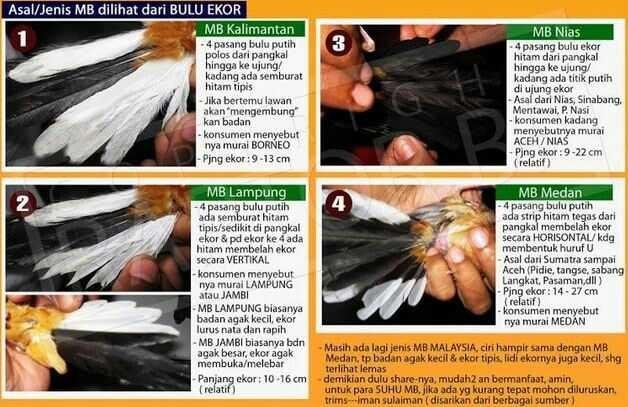
|image source : https://www.kicauburung.id/murai-batu/jenis-murai-batu.html
To get to know what kind of local and overseas stone magpie, let us refer to the detailed explanation of the 11 species of stone magpie according to the following origins.
Kind of Type of Stone Murals in the World With Pictures and Its Explanation:
- Murai Batu Nias
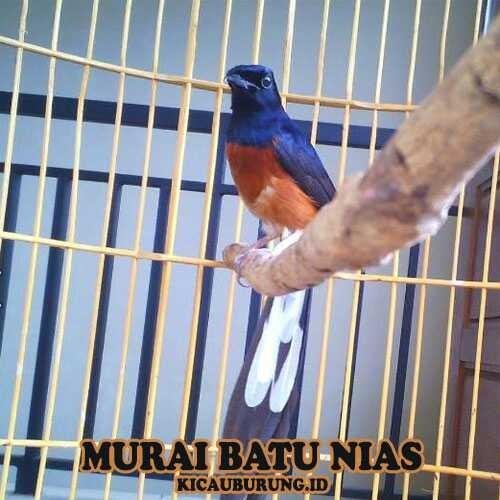
|image source : https://www.kicauburung.id/murai-batu/jenis-murai-batu.html
Nias stone magpie stone is now no longer able to be found easily its original existence. Just like the previous type of stone magpie, the bird in Nias is actually supplied from Simeulue, Sibanang and other areas. This natural habitat of birds is getting less and more with the environment that is no longer healthy, making the scarcity more felt. Especially for those lovers of true birds.
Characteristic of the magpie nias stone lies on the size of this bird's body is smaller and similar to the type of stone magpie from Lampung. The tail feather color of this bird only has one color only, that is black. That is why this magpie bird is also called the blacktail bird age. This black tail can grow with a length of about 17 cm to 20 cm. Uniquely, the resulting sound is quite loud compared to other birds.
This Nias stone magpie can also mimic the sound of other types of magpies faster. So no wonder if this bird is also said to be a reliable imitator. The care of the stone-nosed bird from Nias is quite easy because this bird is not easily attacked by depression or stress. In addition, its rapid adaptation to the surrounding environment will make it easier for birds to be trained and well developed.
- Murai Batu Medan
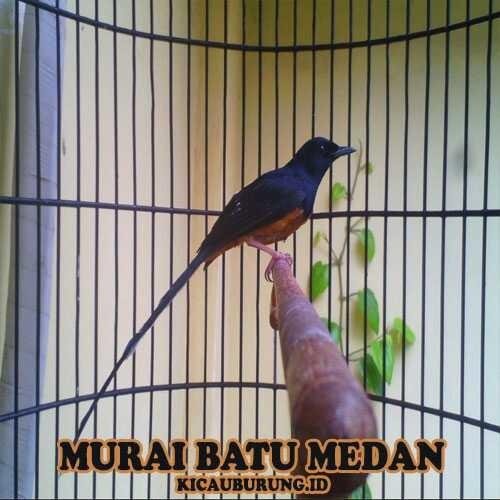
|image source : https://www.kicauburung.id/murai-batu/jenis-murai-batu.html
The type of stone magpie originating from Medan is not native to this area. This kind of bird is said to come from several other areas, such as Aceh and even Peninsular Malaysia. Unfortunately, this bird house in Medan is virtually unavailable. Nowadays bird lovers are already very difficult to look for in areas that usually become their natural habitat, such as Bohorok, Gunung Leuser, and also Bukit Lawang.
The most prominent distinction of the Medan stone magpie bird lies in its posture. His body is bigger and stronger. The color of the feathers also tend to be dark and shiny. For a young stone magpie the rock will have a redder color of the foot, while those who have aged have feet with solid black color. The number of white tail feathers on this bird is counted 4 with a black horizontal stripe.
The length of the feathers of Medan stone magpie birds is about 27 to 30 cm. If the bird is chirping, the ekronya will stand up to touch the head. Size large enough to make the price of this bird is quite expensive in the market. Coupled with the scarcity that hit this bird. As a bird lover, you can also try to preserve one of God's creations on this one.
The next story is a friend of steemit can read from this source https://www.kicauburung.id/murai-batu/jenis-murai-batu.html